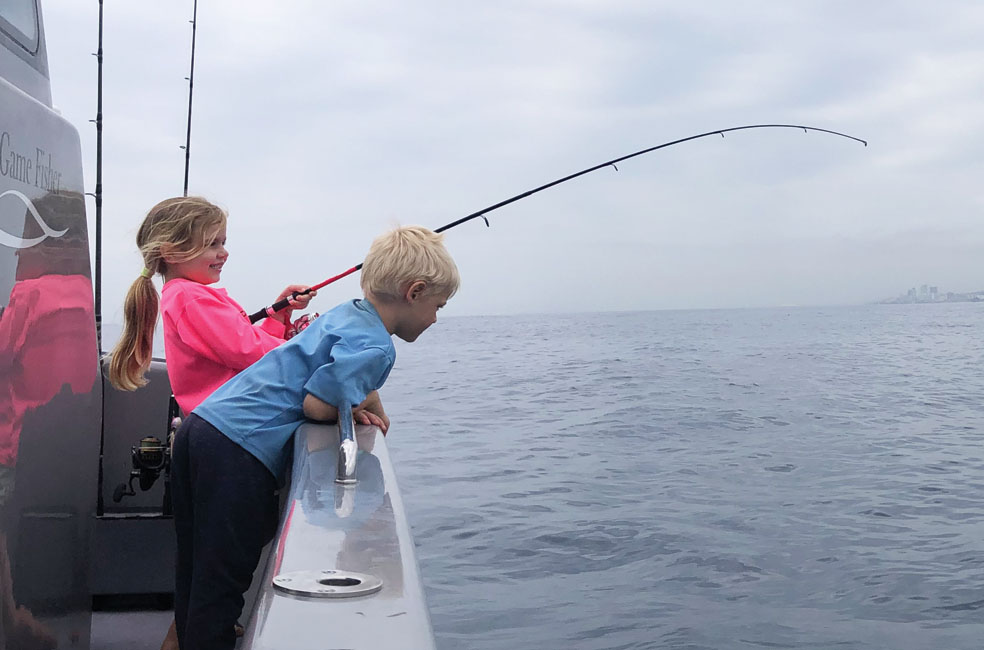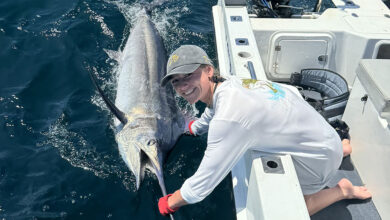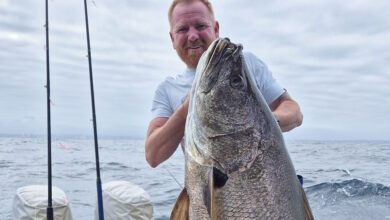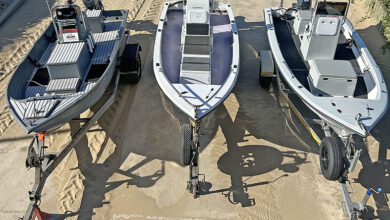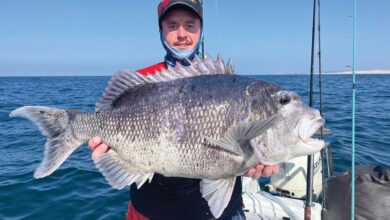GETTING HOOKED
Teaching small fry how to land the big one
By Brett Bartho
(Originally published in the March 2025 issue of SKI-BOAT magazine)
SOME anglers may be able to recall that exact moment when the fish bit and they were hooked for life, while others may have been too young to remember all the nitty gritty details of their first fishy encounter. Either way, rest assured those who found their way onto a boat or had a rod put into their small hands with a fish tugging hard on the other end will most likely be telling stories today of those very same emotions that stirred within them as a youngster.
Those of us fortunate enough to have had the opportunity to go fishing as a young kid out at sea, from the beach or on a dam or river, know it definitely wasn’t about the size of our first fish, but rather the excitement in tussling the unknown object on the end of the line and then the sense of achievement once we’d brought it in.
I’m sure anyone who has taken a newbie or child fishing and got them hooked up to a fish can relate to the sheer joy and excitement that it is experienced in that moment. They are fully immersed in the moment, so much so, in fact, that sometimes the finest details are etched into their memories and recalled many years later as though the event had just occurred.
My brothers and I were blessed to have a grandfather who often took us fishing when we were young. Now we get to do the same with our own children, and, although it requires extra patience and planning, it is an absolute joy to spend time out on the water with them and to share in their excitement.
Here are some tips on how to make the most of these fishing trips with kids, and ensure they get properly hooked.
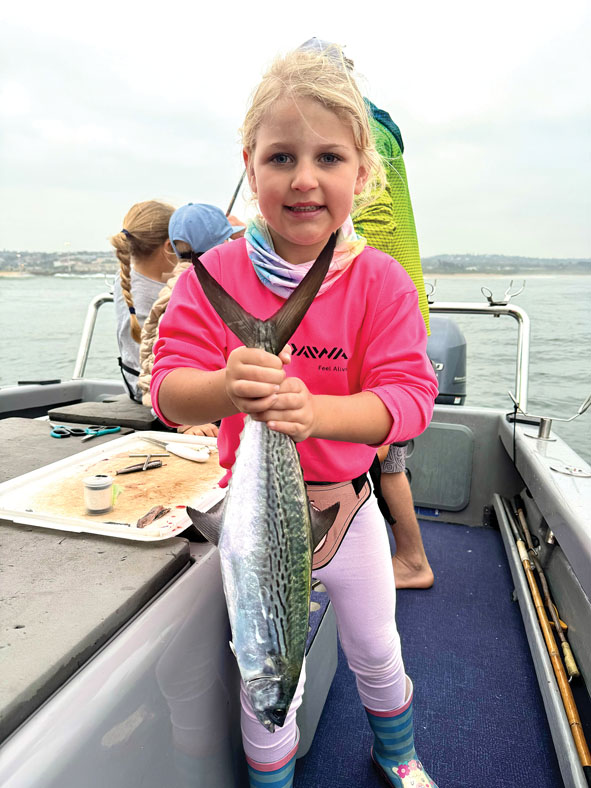
KEEPING IT FUN BEYOND THE CATCH
In the beginning, making sure that they are always having as much fun as possible and enjoying all the elements is what makes a fishing trip exciting and keeps them wanting more. Here it’s often what us oldies consider the small and mundane things, like catching baitfish, seeing dolphins swim by or having a shark eat a fish that bring a lot of joy and interest to the excursion for the young ones.
Show patience and be content with watching the kids do their own bit of fishing. Here catching as many small fish as possible is key, as it keeps them involved and they get a great sense of achievement by hooking and reeling in the fish.
My boys often had the most fun catching livebait with sabiki jigs and then playing with the fish that were swimming in the livewell.
LEARNING VALUABLE LESSONS
Fishing is way more than just a hobby – it’s an opportunity to connect with nature, develop important life skills, and create lasting memories. So, when you teach kids how to fish, you’re not simply teaching them how to catch a fish, you’re also imparting valuable lessons in ethics, sustainability, patience, and enjoying what the outdoors has to offer.
Ethical fishing involves far more than just following local rules and regulations – it’s also about fostering a sense of responsibility towards nature and teaching kids the importance of looking after the beautiful environment that we are blessed with. Lessons here vary from tidying up after one self and not discarding unused or damaged tackle into the ocean or surroundings, to releasing small or unwanted species as quickly and gently as possible to maintain healthy fish populations and ecosystems.
Teaching them the importance of conservation at a young age – and that not every fish caught needs to be kept – will ensure there are fish for future generations to catch.
My brothers and I learnt this valuable lesson from our grandfather. He would always release the smaller of the fish caught out of the keepnet once we’d bagged a bigger fish, and we only ever kept enough to feed the family. He also taught us to look after our catch that we were taking home and then to enjoy what nature had provided for us.
Now, some 40-odd years later, we are passing on this same knowledge and respect to our children. Kids learn a lot quicker by witnessing the actions of elders, and and this has a much longer lasting impression on them than simply reading some article, pamphlet or information on a website.
Other great lessons learnt in our childhood through fishing involved patience, perseverance and, later on, the importance of being prepared.
Fishing is called fishing for a reason, it’s not always “rainbows and unicorns” with catch after catch occurring in quick succession. Learning to be patient will often lead to one of your most memorable catches being made, and so this is a prime opportunity to teach a youngster the importance of this life trait and show them to appreciate being present in the situation.
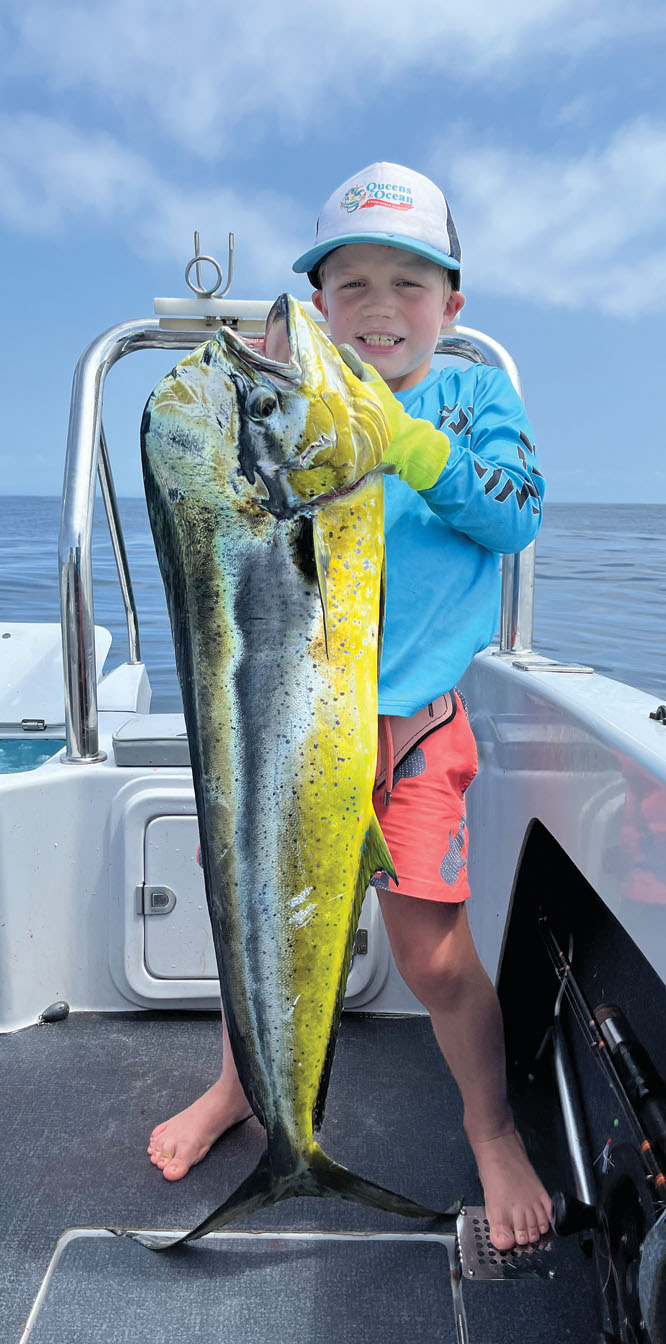
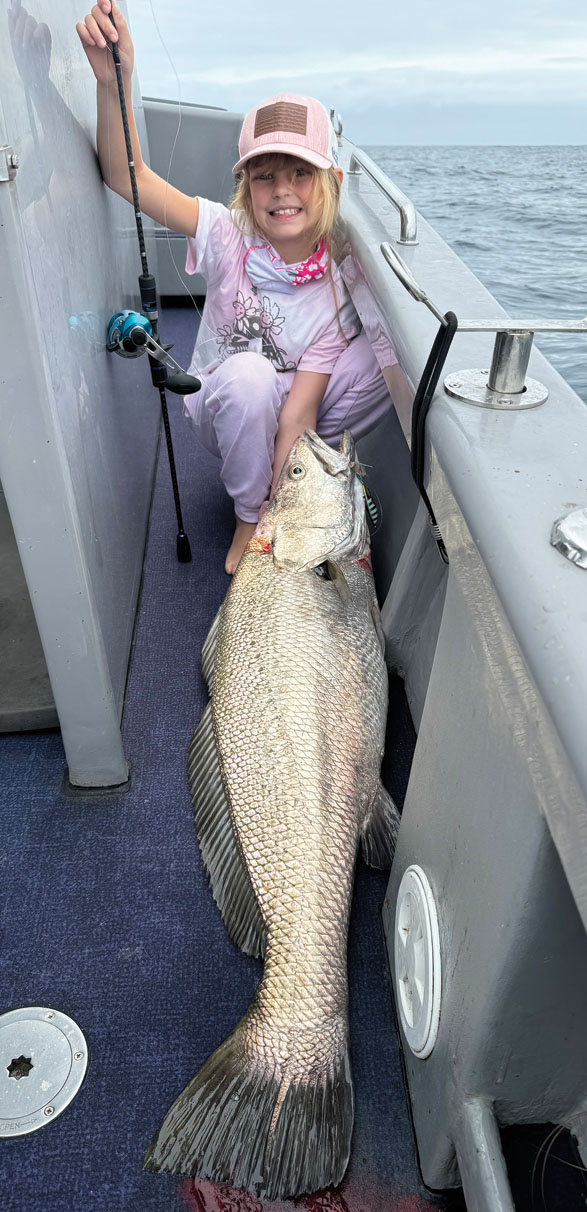
FISHING AS A TOOL FOR GROWTH
The lessons learned while fishing often extend far beyond the water and can help shape kids into more thoughtful, resilient, and responsible individuals.
Encouraging kids to observe patterns out on the water, like which species are active at different times of the day, and how fish respond to certain changes in conditions and baitfish offerings will develop their problem-solving and critical-thinking skills.
It’s key for kids to learn that not every day on the water will be a success and will result in a big catch, but rather that each outing offers an opportunity to learn something new and to grow from such experiences.
Fishing is a wonderful tool to instill a sense of personal responsibility and accomplishment. As kids start to go fishing more regularly, you can begin to teach them to take on more responsibility during these fishing trips. This will teach them the importance of being accountable for their actions – whether it’s planning for a day out on the water, cleaning up after a trip, taking care of their equipment, respecting the environment, or being aware of safety issues.
With more practice they will naturally want to learn the many varied fishing techniques that will make them more successful anglers.
With this gain in experience and a greater understanding of their surroundings and capabilities, it’s always nice to put them up against tougher challenges and piscatorial adversaries. However, here is the catch (pun intended): often one sees photos of kids posing with mighty big fish and immediately one questions the validity of such a small person making such a spectacular catch.
First and foremost, when they’re very young a little assistance is always required. This could be in the form of helping take the rod out of the rod holder and transferring it into the kid’s rod belt, perhaps having a hand on the rod grip to help secure the rod should the fish make an unexpected dash boat side, or gently helping to lift the rod and guide the line evenly onto the reel. I see this as fair game in the non-competitive scene. Remember, we are all here to have fun and learn as we go and grow.
Nowadays, there are far more opportunities for juniors to fish competitively than there were in the past. SADSAA and its various associated bodies are working hard at driving the sport forward and hosting many development clinics, competitive events and offering youngsters the ability to earn national colours. This comes with different rules.
Understandably, providing the bits of help I’ve suggested would be a no-no in a competitive environment where there is either a big value prize dangling or, perhaps, a national title or honours at stake.
This raises the question of whether there should even be such a high value reward at this early age. That’s a topic for a discussion at another time, but personally I would prefer it if every kid were acknowledged for their participation in a competition and then the better catches given slightly more recognition.
Back to fishing for fun …
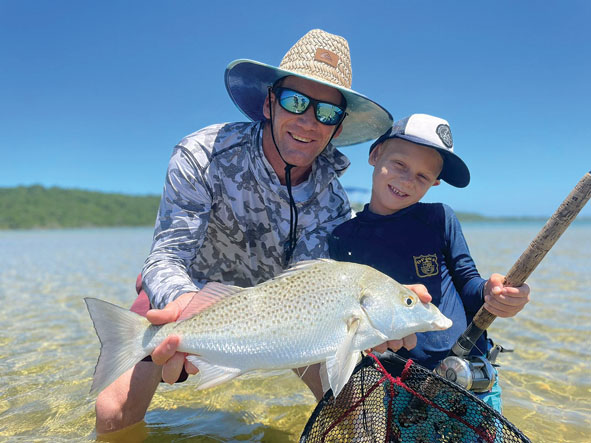
PERSONAL ADVICE FROM MY HUMBLE LEARNINGS
I’ve done loads of fishing with my sons and nieces and other kids, so here are some tips for those just starting out in this area: Start them off slowly. Fishing may not be for everyone from the word go, but if you start with some small simple steps listed below and follow the advice of those more experienced around you, you certainly will be heading in the right direction.
• Keep trips short and ensure they are in a safe setting or conditions.
• Make them as interactive as possible and try to give your child the freedom of choice.
On one occasion my youngest son wanted to jig with a small 15g Halco twisty spoon on a very light spinning rod setup used for catching bonnies. I told him I didn’t think it work considering that we were drifting quite quickly with wind and current. He was persistent and I gave in. He then proceeded to catch on his first down, and then got thoroughly dusted on his second drop! Needless to say, he hasn’t let me forget that, nor has he forgotten that raw feeling of excitement he experienced at hookup.
• Choose tackle that suits their ability.
I started out at the age of two catching spotted grunter from the shore in the Richards Bay harbour with my gran, using 4kg nylon. Now I’m mentoring my boys aged seven and eight. I’ve learnt to let them start on light tackle gear. This way they will quickly learn the importance of “playing” the fish, correct drag setting and then the technique of feeling the fish and learning when and how to slowly lift one’s rod and wind back down to gain line and subdue one’s catch. By using lighter tackle and lower drag settings, you allow the youngster the freedom to handle the rod by themselves and complete their catch unaided.
• Start them out with a fixed-spool reel (coffee grinder) with a fairly light monofilament line (nylon) on a medium length rod with a fairly fast taper. The softer tip is more forgiving and absorbs a lot of the pressure exerted by any fish.
• Make use of fine gauge circle hooks which not only allow for an easy hookup by simply winding onto the fish when they feel the bite, but also often stay in better during the fight. They also allow for a safe and healthy release for the fish.
• Begin with easy-to-learn techniques, such as casting with a spinning rod, how to reel in correctly, and how to tie basic fishing knots. These foundational skills will build their confidence.
On our family holidays to Kosi Bay every year in January, our kids love waking up early and taking their own fishing rods and throwing a line out front for glassies, perch, stumpies and just about anything that will nibble on their hooks. No adult supervision is required here, thanks!
• As they progress, start introducing more complex techniques such as jigging or using more advanced technology such as braided lines, overhead fishing reels and specialised equipment that is capable of catching some amazing fish.
We took my niece out fishing with us on our commercial vessel one day, as she didn’t want to go along to a birthday party her sister was attending. We gave her a light slow pitch jigging outfit and left her to her own devices in the front of the boat. She is a more than capable angler, but we were amazed when this seven-year-old girl pulled up an impressive 16.5kg daga all on her own without a single bit of assistance. While she was fighting it, we all presumed it was just a “decent” rockcod! It ended up being the biggest catch of the day.
Every fish caught, every successful cast, and every new skill learned is a boost to their confidence and fosters a sense of achievement and pride that helps them develop a growth mindset. They’ll learn that, with time and practice, they can improve their skills and overcome many tough challenges.
MAKING MEMORIES FOR LIFE
Finally, remember that it’s not just about the fish they catch – it’s about the memories made, the lessons learnt, and the time you get to spend together out on the water with them. I cherished every moment out on the water with our grandfather, and now relish every moment I get to spend fishing with my two boys.
Whether we end the day with a hatch of nice fish or simply enjoy each others’ company and conversation, the true reward of fishing is in the journey itself and the lasting memories one will always keep.


